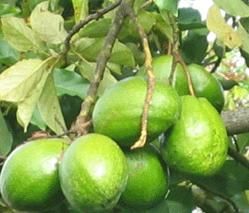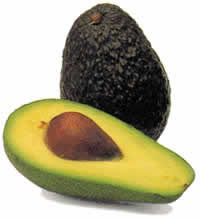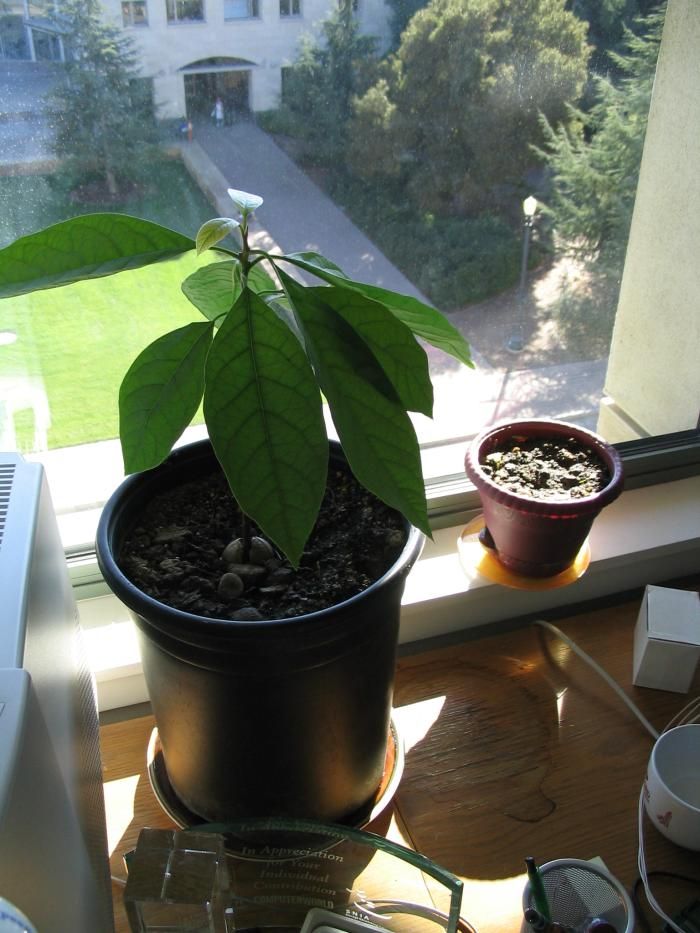Avocado
|
|
|
|
Scientific Name: Persea americana Miller
Common Names: avocado, avocado-pear, aguacate (Spanish)
Family: Lauraceae
Origin: indigenous to tropical America. Three ecological races--Mexican, Guatemalan, and West Indian--are recognized.
History: Avocados have been cultivated in tropical America since pre-Columbian times. The first recorded importation into Florida was in 1833 and into California in 1856.
Description
Tree - A medium (30 ft; 9.1 m) to large (65 ft; 19.8 m) tree, the avocado tree is classified as an evergreen, although some varieties lose their leaves for a short time before flowering. The tree canopy ranges from low, dense and symmetrical to upright and asymmetrical. Limbs are easily broken by strong winds or heavy crop loads.
Leaves - Leaves are 3 to 16 inches (7.6 to 40.1 cm) in length and variable in shape (elliptic, oval, lanceolate). They are often pubescent and reddish when young, then become smooth, leathery, and dark green when mature.
Inflorescence - The many-flowered lateral inflorescences (structures that hold the flowers) are borne in a psuedoterminal position. The central axis of the inflorescence terminates in a shoot. Flowers are perfect, yellowish-green, and 3/8 to 1/2 inch (1 to 1.3 cm) in diameter.
Fruit - The fruit is a berry, consisting of a single large seed, surrounded by a buttery pulp. Fruit contain 3 to 30% oil (Florida varieties range from 3 to 15% oil). The skin is variable in thickness and texture. Fruit color at maturity is green, black, purple or reddish, depending on variety. Fruit shape ranges from spherical to pyriform, and the fruit weigh from a few ounces to 5 lbs (2.3 kg). The fruit does not generally ripen until it falls or is picked from the tree. In Florida, the fruit is considered sufficiently mature for harvest when it reaches a specified calendar date and weight or size. The specific dates, weights, and sizes used to determine maturity vary by variety. An alternative method in some places has been to harvest when the fruit contain a specified minimum oil content and/or dry matter content. However, this method has not proved useful for the varieties of avocados grown in Florida.
Care and cultivation
Spacing and pruning
Planting distances depend on soil type and fertility, current technology, and economic factors. In commercial groves, trees are planted from 15 to 25 feet (4.6 to 7.6 m) in rows and 25 to 30 feet (7.6 to 9.1 m) between rows. Dooryard trees should be planted 25 to 30 feet (7.6 to 9.1 m) away from buildings and other trees.
Formative pruning during the first 2 years may be desirable to encourage lateral growth and multiple framework branching. Commercially, after several years of production it is desirable to occasionally cut back the tops of the trees to 16 to 20 feet (4.9 to 6.1 m). This reduces spraying and harvesting costs and possible storm damage. This operation should be done soon after harvest for early varieties, but after danger of frost has passed for late varieties. Severe topping and hedging (used to reduce canopy width) do not injure trees, but reduce production for one to several seasons.
Planned tree removal is an option that should be seriously considered for commercial plantings before overcrowding and reduced yields begin.
Preliminary studies to rejuvenate non-productive mature orchards with very tall (30 to 40 ft; 9.1 to 12.2 m) trees suggest that production on a per acre basis can be improved when selected trees are removed and remaining trees are topped at 16 to 22 feet (4.9 to 6.7 m). This is because the lower canopy of remaining trees is re-established and production per tree in the orchard exceeds yields of overcrowded trees.
Soils
The avocado does not tolerate flooding or poorly drained soils, but is adapted to many types of well-drained soils. Continuously wet or flooded conditions often result in decreased growth and yields, as well as nutrient deficiency symptoms. Under these conditions, trees are highly susceptible to root infection by Phytophthora fungi. Trees grow well and produce satisfactory yields in the sandy and limestone soils of Florida if maintained with a good fertilizer program.
Fertilizer
In Florida, young trees should be fertilized every 1 to 2 months during the first year, beginning with 1/4 lb (114 g) of fertilizer and increasing to 1 lb (455 g) per tree. Thereafter, three or four applications per year in amounts proportionate to the increasing size of the tree are sufficient. Mature trees should receive 150 to 200 lbs (68 to 91 kg) of nitrogen and potash per acre per year split into three to four applications. Fertilizer mixtures containing 6 to 10% nitrogen (N), 6 to 10% available phosphoric acid (P 2 O 5 ), 6 to 10% potash (K 2 O), and 2 to 6% magnesium (Mg) give satisfactory results with young trees. For bearing trees, available phosphoric acid should be reduced to 2 to 4%.
Plants growing in calcareous soils should receive annual nutritional sprays of copper, zinc, manganese, and boron for the first 4 to 5 years. Thereafter, only zinc, manganese, and possibly boron are necessary. Avocado trees are susceptible to iron deficiency under alkaline conditions. Iron deficiency can be prevented or corrected by periodic soil applications of iron chelates formulated for alkaline conditions.
Irrigation
Avocados are moderately drought tolerant, however, irrigation will be beneficial to plant growth and crop yields during prolonged dry periods. The specific water requirements for mature trees have not been determined. However, as with other tree crops, the period from bloom and through fruit development is important and drought stress should be avoided at this time with periodic irrigation. Once the rainy season arrives, irrigation frequency may be reduced.
Climate
West Indian and some hybrid varieties are best adapted to a lowland tropical climate and relatively frost-free areas of the subtropics. Mexican varieties are more cold-tolerant and not well-adapted to lowland tropical conditions. Guatemalan x Mexican hybrids are generally more cold-tolerant than West Indian x Guatemalan hybrid varieties.
Some of the more cold-tolerant varieties in Florida include: 'Brogdon', 'Gainesville', 'Mexicola', and 'Winter Mexican'. However, it may be difficult to find plants of these varieties. Moderately cold-tolerant types include 'Tonnage', 'Choquette', 'Hall', 'Lula', 'Taylor', 'Monroe', and 'Brookslate'. Varieties with little cold-tolerance include 'Simmonds', 'Pollock', 'Dupuis', 'Nadir', 'Hardee', and 'Waldin'.
Propagation
Most avocado varieties do not come true from seed (i.e., a seed will not render the same variety), so they must be propagated vegetatively. Cleft grafting is the preferred method of propagation in Florida, although veneer grafting also is used. Young, vigorously growing seedlings are used for rootstocks, and terminals of leafy shoots are used for scion material. Grafting is most successful during the cooler months from November through February or March, but can be done from June through March if plant material is available. Established trees may be top-worked by cleft grafting scions of the desired varieties on stumps of cut-back trees or by veneer grafting new sprouts arising from stumped trees. Propagation by cuttings and air-layering has not been successful.
Propagation through seeds:
1. Wash an avocado seed. Suspend it (broad end down) over a water-filled glass using three toothpicks. The water should cover about an inch of the seed.
2. Place the glass in a warm location, out of direct sunlight. A mature seed will crack as roots and stem sprout in about two to six weeks.
3. When a stem grows to six or seven inches, cut it back to about three inches.
4. When the roots are thick and the stem has leafed out again, plant it in a rich humus soil, leaving the seed half exposed. Use a terra cotta pot with a 10-1/2" diameter.
5. Water your avocado house plant generously, but let it dry out somewhat between waterings.
Pests and diseases
- Be sure your avocado house plant is planted in rich humus soil with half the seed exposed.
- Give it frequent, light waterings with occasional deep soakings. Generally, soil should be moist but not saturated.
- The more sunlight your house plant gets, the better.
- If the leaves turn yellow, this is an indication of over watering. Let your house plant dry out for a day or two.
- If the leaves become brown and fry at the tips, too much salt has accumulated in the soil and leaching is required. Let water run freely into the pot and drain out for several minutes.
- When the stem grows to 12 inches high, cut it back to 6 inches. This will encourage growth of new shoots.
- Don't expect your house plant to bear fruit! Although this does occur occasionally, commercially grown avocados require grafting.
Varieties

Articole asemănătoare
-
Salata cu masline, avocado si rosii
O salata de vara consistenta, plina de vitamine si gusturi diverse, proaspata si savuroasa. Maslinele sarate completeaza branza cremoasa, alaturi de avocado, sucul de limeta sau lamaie (dupa gust) si rosiile cherry.
-
Salata de rosii cu avocado si castravete
Salata este o excelenta alegere in zilele calduroase, dar folosind avocado veti transforma o salata simpla cu rosii si castravete intr-o surpriza placuta.
-
Paste cu sos de avocado
Paste cu gust exotic de avocado si multa verdeata, un fel relativ usor de pregatit si plin de arome proaspete, vegetale.
-
Salata verde cu avocado si grepfrut
Daca va place gustul de avocado si vreti sa incercati si alte combinatii aceasta alaturare cu salata verde si aciditatea data de citrice poate fi o varianta castigatoare.
-
Smoothie cu ciocolata neagra, avocado si capsuni
Dominat de aroma intensa a ciocolatei negre, cu notele dulci-acrisoare de capsuna si de vanilie, este o combinatie ce este in acelasi timp un smoothie plin de vitamine, un desert interesant, o bautura revigoranta si un nou fel de a pune in valoare gustul aparte de avocado.


